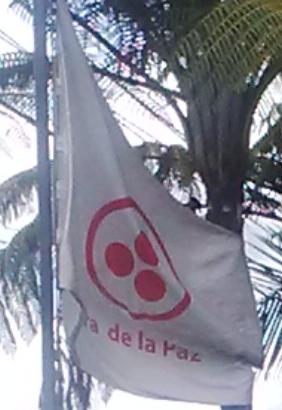![[International Banner of Peace (Roerich Movement flag)]](../images/q/qt-p-ro.gif)
![[International Banner of Peace (Roerich Movement flag)]](../images/q/qt-p-ro1.gif)

Last modified: 2025-03-29 by randy young
Keywords: peace flag | pacifism | international banner of peace | roerich movement | reriq (nikolai~) | disc (red) | discs: 1+2 | madonna oriflamme | painting | saint mary | historical ruins symbol | monument | protection |
Links: FOTW homepage |
search |
disclaimer and copyright |
write us |
mirrors
![[International Banner of Peace (Roerich Movement flag)]](../images/q/qt-p-ro.gif) |
![[International Banner of Peace (Roerich Movement flag)]](../images/q/qt-p-ro1.gif) |
||||
| image by A.H., 29 November 1999 | image by Peter Hans van den Muijzenberg, 5 May 2015 |
António Martins, 30 November 1999In Russia this symbol would be identified nowadays as that of a religious/philosophical group, and nothing more nor less. The one-over-two-dots symbol (no ring) is usually used in cartography to denote important historical remains, usually ruins; maybe it is connected to the Roerich flag, I don't know.
![[Roerich flag donated to UN]](../images/q/qt-p-ro3.jpg)
I don't know how extensively has the pact flag been used.Protection of Artistic and Scientific Institutions and Historic Monuments
The High Contracting Parties, animated by the purpose of giving conventional form to the postulates of the Resolution approved on December 16, 1933, by all the States represented at the Seventh International Conference of American States, held at Montevideo, which recommended to "the Governments of America which have not yet done so that they sign the Roerich Pact , initiated by the Roerich Museum in the United States, and which has as its object, the universal adoption of a flag, already designed and generally known, in order thereby to preserve in any time of danger all nationally and privately owned immovable monuments which form the cultural treasure of peoples," have resolved to conclude a treaty with that end in view, and to the effect that the treasures of culture be respected and protected in time of war and in peace, have agreed upon the following articles: ( )
ARTICLE III
In order to identify the monuments and institutions mentioned in Article I, use may be made of a distinctive flag (red circle with a triple red sphere in the circle on a white background) in accordance with the model attached to this treaty.
signed by the US and other Pan-American Union states, 15 April 1935

![[Roerich flag with PAX inscription]](../images/q/qt-p-rox.gif)
![[Roerich flag with offset emblem]](../images/q/qt-p-ro2.gif)